ReSiPrec - High Resolution Simulations of Extreme Precipitation Events in Baden-Württemberg
- Contact: H. Feldmann, Dr. G. Schädler,Prof. Dr. Ch. Kottmeier
- Project Group:
IMK-TRO
- Funding:
State of Baden-Württemberg
- Startdate:
2007
- Enddate:
2010
Short Description
The task of the project ReSiPrec is to perform high-resolution regional climate simulations and to analyse them with respect to future average and extreme precipitation in the state of Baden-Württemberg.
To achieve this goal, a number of simulations performed by our group
- using the regional climate model (RCM) COSMO-CLM – as well as existing simulations from a variety of RCMs (CLM3, REMO, ENSEMBLES simulations) are combined to establish a so called ensemble. This ensemble contains RCM simulations which cover climatological time scales (several decades) with high spatial resolution.
Several steps are necessary to derive reliable results within this topic:
- To evaluate the RCM simulations using observations for a control period (1971 - 2000)
- To develop suitable methods to describe extreme precipitation events (extreme value statistics) and to quantify reliability and uncertainty of climate change signals (ensemble methods)
- The final step is the application of these methods to achieve an estimate of the changes of (extreme) precipitation within the next decades. The main projection period is 2011 - 2040.
Results
Evaluation of regional climate models
Model evaluation is a necessary step to show the reliability of the model results. It is an essential component of ReSiPrec.
A first study "Feldmann et al., 2008" focuses on the evaluation of precipitation climatologies including regional patterns, annual cycle and distribution of precipitation intensities.
Major findings are:
- The winter precipitation in regional models depends strongly on the input of the global driving model. Large scale precipitation is dominant during winter.
- During summer small scale processes - like convection - have a large impact. The processes are better resolved by the RCMs compared to global models
- Neglecting processes like advection of precipitation causes a spurious windward shift of the precipitation maxima.
With respect to extreme events the regional simulations reproduce the regional distributions well (compare Fig. 1). Like for the mean precipitation there is a tendency to overestimate the extremes as well. More detailed results can be found in "Früh et al., 2010".
Methods to describe extreme events
We apply the peak-over-threshold approach to estimate the intensity of a precipitation event which can be expected once in a certain period (return value for a return period, for instance: intensity of an event in [mm/day] expected to occur one time in 10 years; compare Fig. 1)
"Früh et al., 2010"; "Schädler et al., 2008".
| Simulation CCLM | Observation (REGNIE) |
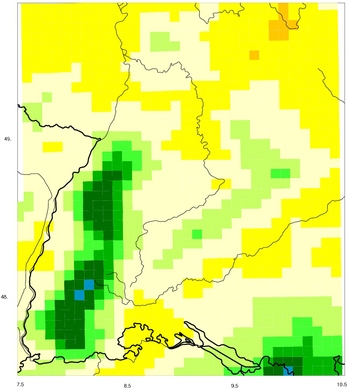 |
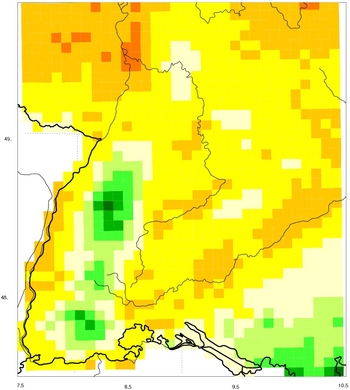 |
 |
|
|
Fig 1: 10-year return value of annual precipitation [mm/day] in Baden-Württemberg; period: 1971 - 2000. Left simulated with CCLM; right: REGNIE gridded observations (DWD) |
|
Ensemble methods and climate signals
Precipitation has large temporal and spatial variability. The spatial variability is caused by the regional topography, land-use ans soil properties and the typical regional weather pattern. The temporal variability reflects the climate forcing due to the greenhouse gases as well as natural variability of the coupled system ocean-atmosphere-soil. Therefore, it is quite difficult to discriminate between climate change signals - which are expected to be relatively small during the next decades - and the “noise” due to natural variability. Even over 30-year periods this natural variability is large. To increase the signal-to-noise ratio we use a set of climate simulations - so called ensembles - to separate the climate change signals "Schädler et al., 2009". The ensemble covers the variability caused by different sources
- Natural variability: Use of simulations with different starting points (realisations)
- Greenhouse gas emissions: Use of different emissions scenarios according to IPCC-SRES
- Physical ensemble: Use of different parameterisations for relevant processes in the models (e.g. convection)
- Especially for regional models different global models should be used to drive them
| MAM | JJA |
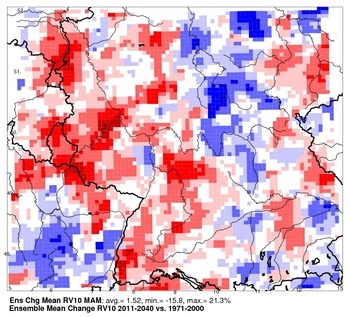 |
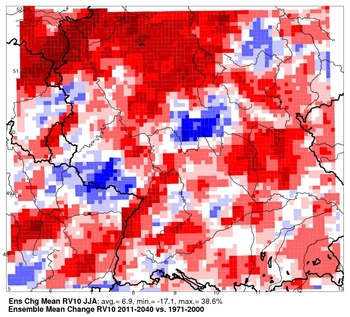 |
| SON | DJF |
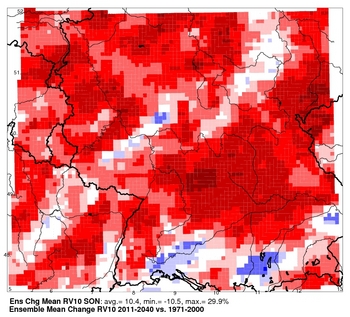 |
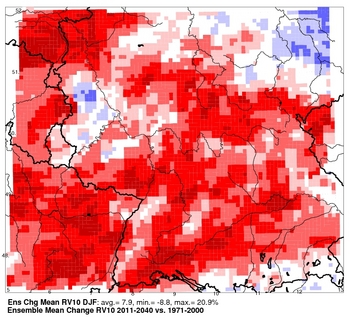 |
 |
|
|
Fig. 2: Near future changes of extreme precipitation in Central Europe. 10-year return value of precipitation - relative change [%] 2011 - 2040 vs. 1971 - 2000 - mean for an ensemble of CCLM simulations. |
|
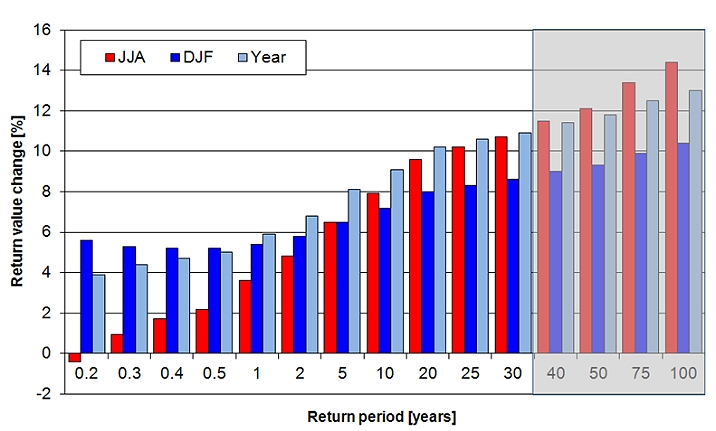 |
|
|
Fig. 3: Near future changes of extreme precipitation for different return periods and seasons- relative change [%] 2011 - 2040 vs. 1971 - 2000 - mean for an ensemble of CCLM simulations. |
|
Major Findings
- The majority of the RCM simulations indicate an increase of precipitation variability. Increased variability makes extreme periods including very wet seasons and droughts more likely; however, the results depend strongly on the driving GCM data.
- Changes in the actual emissions have a delayed impact. This means that the choice of the emission scenario has only a minor influence until the middle of this century.
- It is likely that the precipitation trends observed in the recent past and described in detail in the KLIWA project will prevail at least for the next decades. This implies a shift of the annual cycle with an increase in winter precipitation and dryer summers with only small changes in the annual total precipitation.
- The intensity of extreme events is expected to increase in all seasons. During winter the increase of extremes is consistent with the increase in mean precipitation for this season. During summer – when there is only yet a slight tendency towards less precipitation for the next decades – stronger regional variations of the climate change signal are expected. This leads to an intensification of extreme precipitation events in some regions and a decrease of the intensities in other areas in Middle Europe.
- The increase in the intensity of extreme precipitations gets larger for longer return periods.
Cooperations
- CLM-Community
- LUBW, Baden-Württemberg
- Max Planck Institut for Meteorologie, Hamburg
- Süddeutsches Klimabüro, Karlsruhe
Final Report (german)
-
Hochauflösende regionale Simulationen künftiger Starkniederschlagsereignisse in Baden-Württemberg (ReSiPrec).
Schädler, G., H. Feldmann, H.-J. Panitz, Ch. Kottmeier, B. Früh, 2010:
http://www.herausforderung-klimawandel-bw.de/images/stories/ReSiPrec_Schlussbericht_Herausforderung_Klimawandel.pdf
Publications
- Evaluation of the Precipitation for South-western Germany from High Resolution Simulations with Regional Climate Models
Hendrik Feldmann, Barbara Früh, Gerd Schädler, Hans-Jürgen Panitz, Klaus Keuler, Daniela Jacob and Philip Lorenz
CLM Special Issue „Meteorologische Zeitschrift“, Vol. 17, No. 4, 455 – 465, 2008
- Determination of precipitation return values in complex terrain and their evaluation
Barbara Früh, Hendrik Feldmann, Hans-Jürgen Panitz, Gerd Schädler, Daniela Jacob, Philip Lorenz, and Klaus Keuler
Journal of Climate, 23 (9), 2257-2274, 2010
- Near future changes of extreme precipitation over complex terrain in Central Europe derived from high resolution RCM ensemble simullations
Hendrik Feldmann, Gerd Schädler, Hans-Jürgen Panitz, Christoph Kottmeier
International Journal of Climatology, DOI: 10.1002/joc3364, 2012
Conferences
- Hochauflösende regionale Simulationen künftiger Starkniederschlagsereignisse in Baden-Württemberg - Projekt ReSiPrec
Hendrik Feldmann
Abschlusssymposium des Programms, Stuttgart, 12. Mai 2010
